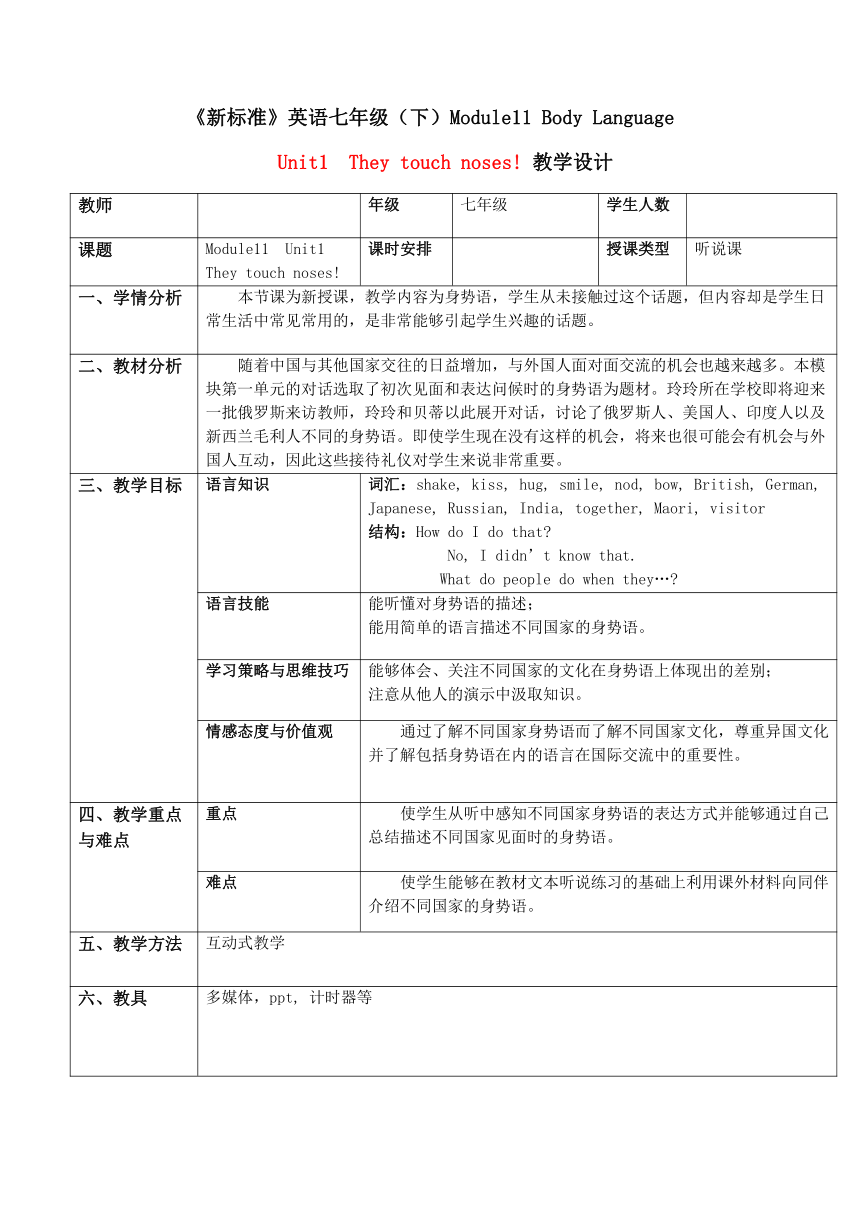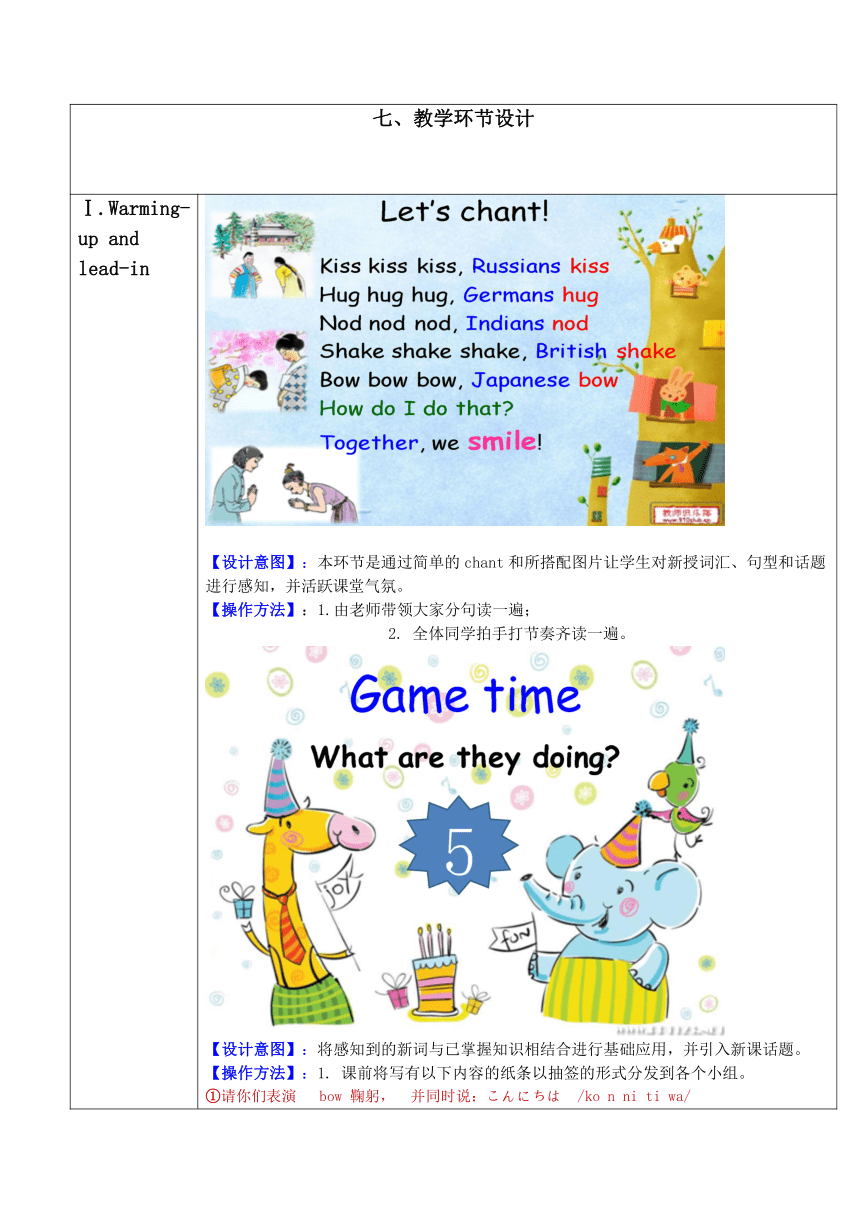外研版英语七年级下Module 11 Body languageUnit 1 They touch noses!教学设计(1课时)
文档属性
| 名称 | 外研版英语七年级下Module 11 Body languageUnit 1 They touch noses!教学设计(1课时) |  | |
| 格式 | zip | ||
| 文件大小 | 5.9MB | ||
| 资源类型 | 教案 | ||
| 版本资源 | 外研版 | ||
| 科目 | 英语 | ||
| 更新时间 | 2020-04-25 22:52:59 | ||
图片预览





文档简介
《新标准》英语七年级(下)Module11 Body Language
Unit1 They touch noses! 教学设计
教师 年级 七年级 学生人数
课题 Module11 Unit1 They touch noses! 课时安排 授课类型 听说课
一、学情分析 本节课为新授课,教学内容为身势语,学生从未接触过这个话题,但内容却是学生日常生活中常见常用的,是非常能够引起学生兴趣的话题。
二、教材分析 随着中国与其他国家交往的日益增加,与外国人面对面交流的机会也越来越多。本模块第一单元的对话选取了初次见面和表达问候时的身势语为题材。玲玲所在学校即将迎来一批俄罗斯来访教师,玲玲和贝蒂以此展开对话,讨论了俄罗斯人、美国人、印度人以及新西兰毛利人不同的身势语。即使学生现在没有这样的机会,将来也很可能会有机会与外国人互动,因此这些接待礼仪对学生来说非常重要。
三、教学目标 语言知识 词汇:shake, kiss, hug, smile, nod, bow, British, German, Japanese, Russian, India, together, Maori, visitor结构:How do I do that? No, I didn’t know that. What do people do when they…?
语言技能 能听懂对身势语的描述;能用简单的语言描述不同国家的身势语。
学习策略与思维技巧 能够体会、关注不同国家的文化在身势语上体现出的差别;注意从他人的演示中汲取知识。
情感态度与价值观 通过了解不同国家身势语而了解不同国家文化,尊重异国文化并了解包括身势语在内的语言在国际交流中的重要性。
四、教学重点与难点 重点 使学生从听中感知不同国家身势语的表达方式并能够通过自己总结描述不同国家见面时的身势语。
难点 使学生能够在教材文本听说练习的基础上利用课外材料向同伴介绍不同国家的身势语。
五、教学方法 互动式教学
六、教具 多媒体,ppt, 计时器等
七、教学环节设计
Ⅰ.Warming-up and lead-in ?Kiss kiss kiss, Russians kiss
Hug hug hug, Germans hug
Nod nod nod, Indians nod
Shake shake shake, British shake
Bow bow bow, Japanese bow
How do I do that?
Together, we smile!
Let’s chant!
? 【设计意图】:本环节是通过简单的chant和所搭配图片让学生对新授词汇、句型和话题进行感知,并活跃课堂气氛。【操作方法】:1.由老师带领大家分句读一遍; 2. 全体同学拍手打节奏齐读一遍。?Game time
What are they doing?
1
2
3
4
5
?【设计意图】:将感知到的新词与已掌握知识相结合进行基础应用,并引入新课话题。【操作方法】:1. 课前将写有以下内容的纸条以抽签的形式分发到各个小组。①请你们表演 bow 鞠躬, 并同时说:こんにちは /ko n ni ti wa/②请两名女同学以 左-右-左 贴脸的方式表演 kiss 亲吻 并同时说:как дела(嘎可接辣)③请你们表演shake hands 握手, 并同时说:你好!④请两名男同学表演初次见面 touch noses 碰鼻子 。 ⑤请两名同学表演nod heads 点头 并 说: ?????????? 、????????? /sa wat dee krap / 2.五组按序号表演并由其他同学猜出他们所做的动作,老师将相应的词写在黑板上;领读生词并标注音标。 3. 由板书内容引入新课话题:body language
Ⅱ. Listening、reading and speaking ?
2 Listen and match the pictures with the
nationality.
British
French
German
Japanese
Russian
1
3
2
?【设计意图】:听并获取不同国家见面时所用手势语的具体信息。【操作方法】:1.让学生预览图片内容; 2. 听一遍,并进行匹配,举手抢答反馈。?1. What countries are talked about in the conversation?
Listen and answer.
Russian, Chinese, American, Indian, and Maori.
2. What do Maori people do when they meet?
They touch noses!
?【设计意图】:听对话,获取相关信息,感知不同国家见面时所用的身势语,并回答两个问题。【操作方法】:1. 请两名同学读问题,保证所有学生带着清楚的问题有目的性的听力;2.播放一遍录音,指导学生将答案写在学案卷上;举手反馈。?Read and complete the table
In Russia Kiss _______ times, left, right, left When they meet visitors.
In China ________ hands and smile
In the US Some shake hands and smile, and sometimes _______or ______each other
In India Put their hands _______ and ______their heads
In New Zealand _______ noses
Touch
together
hug
kiss
Shake
three
nod
A: What do they do when they meet visitors in China?
B: They ...
People in different countries use different body languages when they meet visitors. In Russia…
?【设计意图】:通过阅读获取具体信息并在此过程中对信息进行分类总结。【操作方法】:1. 自己完成阅读并完成表格; 2. 两人一组进行问答练习:A: What do they do when they meet visitors in China? B: They ... 3. 小组为单位讨论练习复述对话,用自己的语言介绍这几个国家见面时所用的不同身势语。People in different countries use different body languages when they meet visitors. In Russia…?What do people do when they meet Russians?
Kiss kiss kiss, Russians kiss
What do people do when they meet Germans?
Hug hug hug, Germans hug
What do people do when they meet Indians?
Nod nod nod, Indians nod
What do people do when they meet British?
Shake shake shake, British shake
What do people do when they meet Japanese?
Bow bow bow, Japanese bow
How do I do that? Together, we smile!
Let’s chant!
?【设计意图】:阶段小结,通过加大难度的chant对以上环节所学词汇和句型进行强化,并再次调整课堂气氛,将整堂课推向下一个高潮。【操作方法】:全班一起拍手Chant。
Ⅲ. Speaking (Language use) ?文化沙龙 Culture salon
Body languages around you
每组抽一个国家,根据所给信息讨论该国的肢体语言。
到不同的小组进行采访,并记录在学案上相应位置。
--- What do Russians do when they meet?
--- They kiss each other three times.
--- What…? …
在本组内将采访结果进行总结汇报。
eg. Russians kiss each other when they meet, but Chinese don’t do that. They shake hands. Americans…
?【设计意图】:以学校英语文化沙龙为载体,应用本节课所学知识和老师所给材料讨论不同国家身势语。(所给材料见附录)【操作方法】:1. 每个小组抽取一份材料并组内讨论所抽国家的身势语信息。 2.在全班范围内采访你所感兴趣的国家身势语。 3.回到组内进行讨论,将采访到的不同信息进行交流总结,以小组为单位向大家进行介绍。(由学生进行打分并分析原因)
Ⅳ. Summary ?Summary
?【设计意图】:在本课即将结束的时候,引导学生总结本课学习到的内容。【操作方法】:全班起立,举手抢答。(规则:不允许与之前说过的重复)
Ⅴ. Homework 课后搜集信息,将中国的身势语与不同国家的进行对比。
附录:不过国家身势语信息。
British
When they meet, they often shake hands, hug or kiss.
When they want to say ”Congratulations!”(祝贺你!), they often cross their fingers(食指和中指交叠起来).
When they want to win (胜利), they often make a V.
When they want to get a lift (搭便车), they often do this.
When they want to say “I don’t know that! ” or “I don't like it!”, they often shrug their shoulders ( 耸肩).
When …
GermanWhen they meet visitors, they often shake hands. When they meet family or friends, they often hug. When they want to ask someone to come. ?????????? ?When they want to say “Great!(棒极了)”????????????? ?When they are excited at a concert(在演唱会上兴奋), they will do this. ??? ??????When they want to say something in class(想在课堂上发言). ????? ??
Chinese
When they meet, they often shake hands. Parents and children often hug or kiss.
When they want to say “I am not interested in that. (我不感兴趣)”, they often shrug their shoulders ( 耸肩).
When they are excited at a concert(在演唱会上兴奋), they will put up their hands to the sky (双手向上伸直).
When they want to say “ I love you.” They often do this.
When they meet teachers, they often bow.
When they want to say “8”, they often do this.
Japanese
When they meet, they often bow.
When they want to say “No!”, they often do this.
When they want to say “man(男人), they often do this.
When they want to say ‘woman’(女人), they often do this.
When they want to say “OK” or “money(钱)”, they often do this.
Russians
When they meet, they often kiss three times, left- right- left.
When they are surprised(惊讶), they often shrug their shoulders.(耸肩)
When they are excited at a concert(在演唱会上兴奋), they will do this.
??? ??????
When they want to say “2”, they will do this.
When they want a lift(搭便车) or taxi(打车), they often put up one hand. (举手)
Unit1 They touch noses! 教学设计
教师 年级 七年级 学生人数
课题 Module11 Unit1 They touch noses! 课时安排 授课类型 听说课
一、学情分析 本节课为新授课,教学内容为身势语,学生从未接触过这个话题,但内容却是学生日常生活中常见常用的,是非常能够引起学生兴趣的话题。
二、教材分析 随着中国与其他国家交往的日益增加,与外国人面对面交流的机会也越来越多。本模块第一单元的对话选取了初次见面和表达问候时的身势语为题材。玲玲所在学校即将迎来一批俄罗斯来访教师,玲玲和贝蒂以此展开对话,讨论了俄罗斯人、美国人、印度人以及新西兰毛利人不同的身势语。即使学生现在没有这样的机会,将来也很可能会有机会与外国人互动,因此这些接待礼仪对学生来说非常重要。
三、教学目标 语言知识 词汇:shake, kiss, hug, smile, nod, bow, British, German, Japanese, Russian, India, together, Maori, visitor结构:How do I do that? No, I didn’t know that. What do people do when they…?
语言技能 能听懂对身势语的描述;能用简单的语言描述不同国家的身势语。
学习策略与思维技巧 能够体会、关注不同国家的文化在身势语上体现出的差别;注意从他人的演示中汲取知识。
情感态度与价值观 通过了解不同国家身势语而了解不同国家文化,尊重异国文化并了解包括身势语在内的语言在国际交流中的重要性。
四、教学重点与难点 重点 使学生从听中感知不同国家身势语的表达方式并能够通过自己总结描述不同国家见面时的身势语。
难点 使学生能够在教材文本听说练习的基础上利用课外材料向同伴介绍不同国家的身势语。
五、教学方法 互动式教学
六、教具 多媒体,ppt, 计时器等
七、教学环节设计
Ⅰ.Warming-up and lead-in ?Kiss kiss kiss, Russians kiss
Hug hug hug, Germans hug
Nod nod nod, Indians nod
Shake shake shake, British shake
Bow bow bow, Japanese bow
How do I do that?
Together, we smile!
Let’s chant!
? 【设计意图】:本环节是通过简单的chant和所搭配图片让学生对新授词汇、句型和话题进行感知,并活跃课堂气氛。【操作方法】:1.由老师带领大家分句读一遍; 2. 全体同学拍手打节奏齐读一遍。?Game time
What are they doing?
1
2
3
4
5
?【设计意图】:将感知到的新词与已掌握知识相结合进行基础应用,并引入新课话题。【操作方法】:1. 课前将写有以下内容的纸条以抽签的形式分发到各个小组。①请你们表演 bow 鞠躬, 并同时说:こんにちは /ko n ni ti wa/②请两名女同学以 左-右-左 贴脸的方式表演 kiss 亲吻 并同时说:как дела(嘎可接辣)③请你们表演shake hands 握手, 并同时说:你好!④请两名男同学表演初次见面 touch noses 碰鼻子 。 ⑤请两名同学表演nod heads 点头 并 说: ?????????? 、????????? /sa wat dee krap / 2.五组按序号表演并由其他同学猜出他们所做的动作,老师将相应的词写在黑板上;领读生词并标注音标。 3. 由板书内容引入新课话题:body language
Ⅱ. Listening、reading and speaking ?
2 Listen and match the pictures with the
nationality.
British
French
German
Japanese
Russian
1
3
2
?【设计意图】:听并获取不同国家见面时所用手势语的具体信息。【操作方法】:1.让学生预览图片内容; 2. 听一遍,并进行匹配,举手抢答反馈。?1. What countries are talked about in the conversation?
Listen and answer.
Russian, Chinese, American, Indian, and Maori.
2. What do Maori people do when they meet?
They touch noses!
?【设计意图】:听对话,获取相关信息,感知不同国家见面时所用的身势语,并回答两个问题。【操作方法】:1. 请两名同学读问题,保证所有学生带着清楚的问题有目的性的听力;2.播放一遍录音,指导学生将答案写在学案卷上;举手反馈。?Read and complete the table
In Russia Kiss _______ times, left, right, left When they meet visitors.
In China ________ hands and smile
In the US Some shake hands and smile, and sometimes _______or ______each other
In India Put their hands _______ and ______their heads
In New Zealand _______ noses
Touch
together
hug
kiss
Shake
three
nod
A: What do they do when they meet visitors in China?
B: They ...
People in different countries use different body languages when they meet visitors. In Russia…
?【设计意图】:通过阅读获取具体信息并在此过程中对信息进行分类总结。【操作方法】:1. 自己完成阅读并完成表格; 2. 两人一组进行问答练习:A: What do they do when they meet visitors in China? B: They ... 3. 小组为单位讨论练习复述对话,用自己的语言介绍这几个国家见面时所用的不同身势语。People in different countries use different body languages when they meet visitors. In Russia…?What do people do when they meet Russians?
Kiss kiss kiss, Russians kiss
What do people do when they meet Germans?
Hug hug hug, Germans hug
What do people do when they meet Indians?
Nod nod nod, Indians nod
What do people do when they meet British?
Shake shake shake, British shake
What do people do when they meet Japanese?
Bow bow bow, Japanese bow
How do I do that? Together, we smile!
Let’s chant!
?【设计意图】:阶段小结,通过加大难度的chant对以上环节所学词汇和句型进行强化,并再次调整课堂气氛,将整堂课推向下一个高潮。【操作方法】:全班一起拍手Chant。
Ⅲ. Speaking (Language use) ?文化沙龙 Culture salon
Body languages around you
每组抽一个国家,根据所给信息讨论该国的肢体语言。
到不同的小组进行采访,并记录在学案上相应位置。
--- What do Russians do when they meet?
--- They kiss each other three times.
--- What…? …
在本组内将采访结果进行总结汇报。
eg. Russians kiss each other when they meet, but Chinese don’t do that. They shake hands. Americans…
?【设计意图】:以学校英语文化沙龙为载体,应用本节课所学知识和老师所给材料讨论不同国家身势语。(所给材料见附录)【操作方法】:1. 每个小组抽取一份材料并组内讨论所抽国家的身势语信息。 2.在全班范围内采访你所感兴趣的国家身势语。 3.回到组内进行讨论,将采访到的不同信息进行交流总结,以小组为单位向大家进行介绍。(由学生进行打分并分析原因)
Ⅳ. Summary ?Summary
?【设计意图】:在本课即将结束的时候,引导学生总结本课学习到的内容。【操作方法】:全班起立,举手抢答。(规则:不允许与之前说过的重复)
Ⅴ. Homework 课后搜集信息,将中国的身势语与不同国家的进行对比。
附录:不过国家身势语信息。
British
When they meet, they often shake hands, hug or kiss.
When they want to say ”Congratulations!”(祝贺你!), they often cross their fingers(食指和中指交叠起来).
When they want to win (胜利), they often make a V.
When they want to get a lift (搭便车), they often do this.
When they want to say “I don’t know that! ” or “I don't like it!”, they often shrug their shoulders ( 耸肩).
When …
GermanWhen they meet visitors, they often shake hands. When they meet family or friends, they often hug. When they want to ask someone to come. ?????????? ?When they want to say “Great!(棒极了)”????????????? ?When they are excited at a concert(在演唱会上兴奋), they will do this. ??? ??????When they want to say something in class(想在课堂上发言). ????? ??
Chinese
When they meet, they often shake hands. Parents and children often hug or kiss.
When they want to say “I am not interested in that. (我不感兴趣)”, they often shrug their shoulders ( 耸肩).
When they are excited at a concert(在演唱会上兴奋), they will put up their hands to the sky (双手向上伸直).
When they want to say “ I love you.” They often do this.
When they meet teachers, they often bow.
When they want to say “8”, they often do this.
Japanese
When they meet, they often bow.
When they want to say “No!”, they often do this.
When they want to say “man(男人), they often do this.
When they want to say ‘woman’(女人), they often do this.
When they want to say “OK” or “money(钱)”, they often do this.
Russians
When they meet, they often kiss three times, left- right- left.
When they are surprised(惊讶), they often shrug their shoulders.(耸肩)
When they are excited at a concert(在演唱会上兴奋), they will do this.
??? ??????
When they want to say “2”, they will do this.
When they want a lift(搭便车) or taxi(打车), they often put up one hand. (举手)
同课章节目录
- Module 1 Lost and found
- Unit 1 Whose bag is this?
- Unit 2 Are they yours?
- Unit 3 Language in use
- Module 2 What can you do ?
- Unit 1 I can play the piano
- Unit 2 I can run really fast
- Unit 3 Language in use
- Module 3 Making plans
- Unit 1 What are you going to do at the weekends?
- Unit 2 We're going to cheer the players.
- Unit 3 Language in use
- Module 4 Life in the future
- Unit 1 Everyone will study at home
- Unit 2 Every family will have a small plane.
- Unit 3 Language in use
- Module 5 Shopping
- Unit 1 What can I do for you?
- Unit 2 You can buy everything on the Internet
- Unit 3 Language in use
- Module 6 Around town
- Unit 1 Could you tell me how to get to the Nationa
- Unit 2 The London Eye is on your right.
- Unit 3 Language in use
- Revision module A
- Module 7 My past life
- Unit 1 I was born in a small village.
- Unit 2 I was born in Quincy.
- Unit 3 Language in use
- Module 8 Story time
- Unit 1 Once upon a time….
- Unit 2 Goldilocks hurried out of the house.
- Unit 3 Language in use
- Module 9 Life history
- Unit 1 He left school and began work at the age of
- Unit 2 He decided to be an actor.
- Unit 3 Language in use
- Module 10 A holiday journey
- Unit 1 What did you do?
- Unit 2 This morning we took a walk.
- Unit 3 Language in use
- Module 11 Body language
- Unit 1 They touch noses!
- Unit 2 Here are some ways to welcome them.
- Unit 3 Language in use
- Module 12 Western music
- Unit 1 It's so beautiful!
- Unit 2 Vienna is the centre of European classical
- Unit 3 Language in use
- Revision module B
